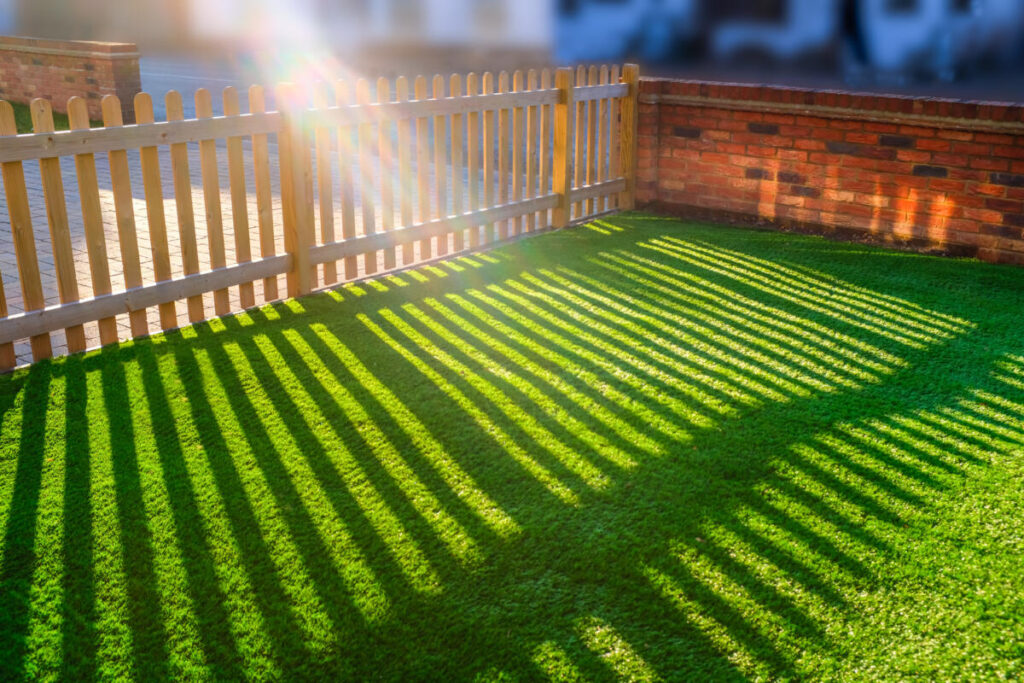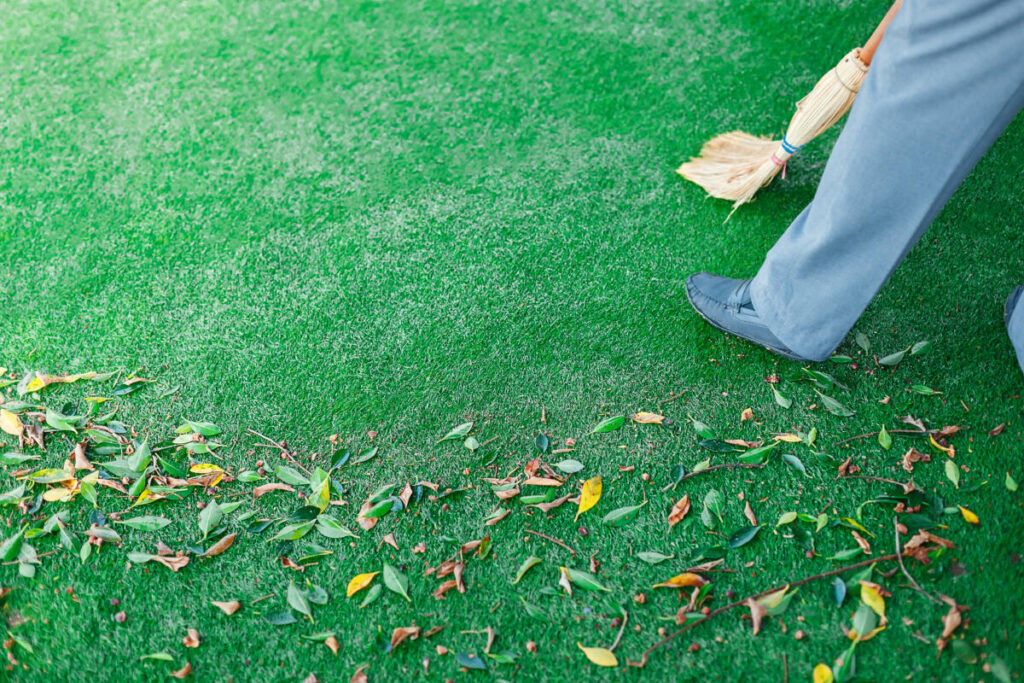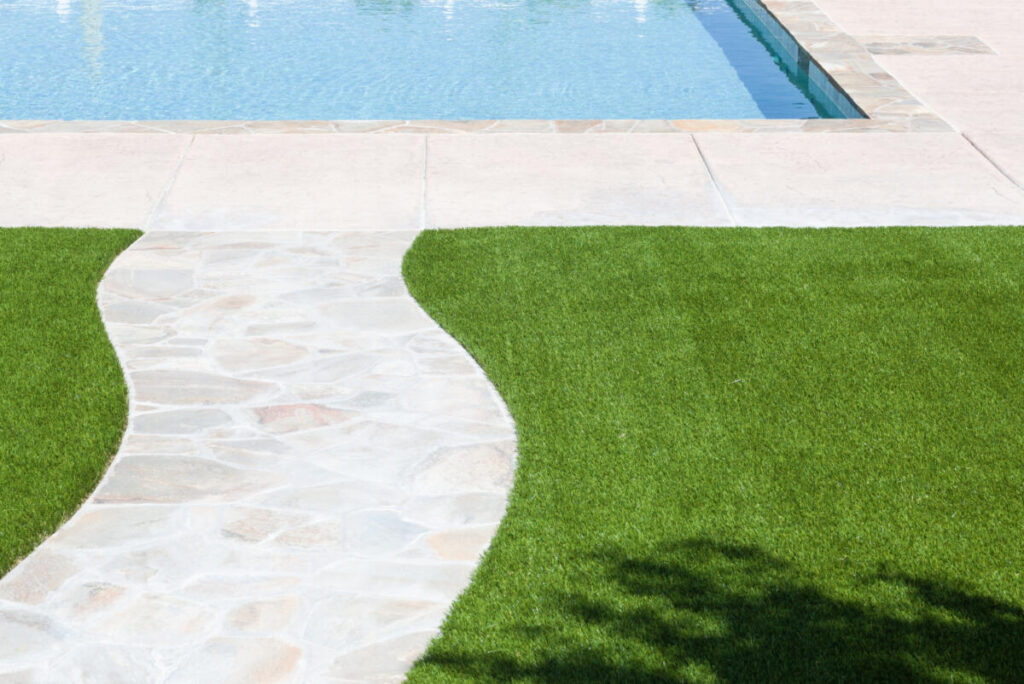If you’ve ever considered installing artificial grass, it’s natural to wonder, “how long does artificial grass last?” After all, investing in a low-maintenance, beautiful lawn should be worth every penny, right? This article will help uncover the factors that determine how long artificial grass lasts and provide tips on maximizing its lifespan. Let’s explore the world of synthetic turf and its impressive durability!
Key Takeaways
The lifespan of artificial grass depends on quality, installation process, use, and ongoing maintenance.
Proper care and maintenance can extend its longevity.
Regular cleaning, repair protocols & selecting quality turf products maximize the lifespan of synthetic turf.
The Lifespan of Artificial Grass: Key Factors
The longevity of artificial grass depends on several factors, such as material quality, installation, and maintenance. When these factors are carefully considered, high-quality artificial turf can last up to an impressive 20 years. That being said, here’s how certain factors can affect the lifespan of artificial turf, both positively and negatively.
Material Quality
The durability and longevity of synthetic grass is heavily influenced by the materials used in its production. High-quality artificial grass is typically made from polypropylene, polyethylene, or nylon, which are synthetic fibers that ensure a long-lasting and resilient lawn.
Each material has its advantages and disadvantages. For instance, basic quality plastic like polypropylene is an economical choice but is less resilient compared to polyethylene or nylon. Polyethylene offers a realistic look and high resilience. Nylon is the most durable but comes at a higher price.
Choosing a material that aligns with your needs and expected foot traffic is a pivotal decision for extending the life of your artificial lawn.
Installation

The durability and lifespan of artificial grass heavily also hinge on proper installation. A professional installation process, such as installing artificial turf, involves:
Preparing the area
Installing a stable base for drainage
Rolling out and cutting the artificial grass
Securing it in place
Applying synthetic turf infill for added stability and cushioning.
When done correctly, accurate installation guarantees a level surface, secure boundaries, and extended durability. On the other hand, inadequate installation can lead to decreased longevity, uneven terrain, inadequate drainage, creases, folds, and insufficient infill.
For optimal results, it’s vital to choose professional installation services and high-quality materials.
Maintenance
Despite artificial grass requiring much less maintenance than natural grass, consistent upkeep is necessary to extend its lifespan. Maintenance activities include:
Eliminating debris
Rinsing the turf frequently
Brushing the grass
Managing weeds
Quickly eliminating stains
Collecting pet waste
Experts recommend rinsing artificial turf at least once a week to remove dust and debris, with a more thorough cleaning once a month. Regular attention to maintenance tasks can help maintain its pristine condition and functionality.
How Usage Affects Longevity
The way artificial grass is used can significantly impact its lifespan. Factors such as foot traffic, pets, and intended use all play a role in determining the durability of your artificial turf. Here are some of the most common scenarios of artificial turf usage that can impact its lifespan.
Foot Traffic
High foot traffic areas may experience faster wear and tear, leading to a shorter lifespan for your artificial grass. However, proper maintenance can help mitigate the effects of foot traffic, ensuring that your grass remains in top condition for longer.
For areas with extremely high volume of foot traffic, consider opting for artificial grass with a higher face weight, typically 70 ounces or above, to withstand the demands of constant use. A carefully selected type of artificial grass, coupled with regular maintenance, can guarantee a prolonged lifespan, even in areas with high foot traffic.
Pets and Artificial Grass
Pet waste and activity can affect the lifespan of your artificial grass. However, there are steps you can take to maintain its lifespan:
Regularly clean up after your pets to remove any waste.
Use pet-friendly cleaning products to eliminate any residue and odors.
Consider using pet-friendly infill to help prevent damage to the grass.
By following these steps, you can ensure that your artificial grass stays in good condition for longer.
Pets may also cause damage to artificial grass through digging, so it’s crucial to monitor their behavior and address any issues promptly. By implementing proper care and maintenance, you can ensure that your artificial grass remains in excellent condition despite the challenges posed by pets.
Sports Fields vs. Residential Lawns
A common question is how long artificial grass lasts on sports fields vs. residential lawns. Sports field artificial turf typically has a shorter lifespan, lasting around 10-15 years without maintenance, while residential artificial grass can last up to 20 years. The synthetic grass lifespan varies depending on factors such as usage and maintenance.
The type of sport played on artificial grass can also influence its lifespan. Choosing professional-grade artificial grass engineered for enhanced durability and longevity, alongside implementing proper maintenance practices, helps it withstand these external factors.
Weather and Environmental Factors

Weather and environmental factors can also have a significant impact on the lifespan of artificial grass. Sun exposure and extreme weather conditions can cause damage, but proper installation and maintenance can help reduce their impact.
An exploration of how sun exposure and extreme weather conditions can impact the durability of artificial grass, and the measures to mitigate these effects, is in order.
Sun Exposure
Prolonged sun exposure can cause fading and reduced longevity of your artificial grass. UV-stabilized turf can help prevent discoloration by protecting the grass from the damaging effects of UV radiation.
Investing in UV-stabilized artificial grass offers several benefits:
Retains color and appearance for up to two decades, even when exposed to direct sunlight
Protects against the damaging effects of sun exposure
Ensures a long-lasting and vibrant lawn
Choosing UV-resistant turf and following proper maintenance practices are essential for preserving the quality and longevity of your artificial grass.
Extreme Weather Conditions
Extreme weather conditions can cause damage to your artificial grass. Heavy rainfall can lead to water damage if your artificial grass does not have a proper drainage system, while extreme heat can cause the plastic blades of artificial grass to overheat, making it unusable.
Ensuring the correct installation and proper maintenance of your artificial grass is fundamental in mitigating the impact of extreme weather conditions.
Signs It’s Time to Replace Your Artificial Grass
Knowing when to replace your artificial grass is crucial for maintaining a functional and aesthetically pleasing lawn. Signs that it’s time to replace your artificial grass include visible seams and separation, discoloration and fading, and uneven surfaces and safety hazards.
Further examination of these signs will aid in identifying the right time to replace your artificial grass.
Visible Seams and Separation
Visible seams and separation in your artificial grass can be indicative of wear and tear or improper installation. If you notice visible seams, it may be time to consider replacing your turf or repairing the damaged areas.
Repairing visible seams can be done using seaming tape and glue to secure the seams. If the damage is extensive or the seams are beyond repair, it may be necessary to invest in a new artificial grass installation.
Discoloration and Fading
Discoloration and fading are signs of aging and may necessitate turf replacement. Prolonged sun exposure, chemical exposure, and wear and tear can all contribute to the fading and discoloration of your artificial grass.
To prevent discoloration and fading, opt for UV-stabilized turf and follow proper maintenance practices, such as regular cleaning and using appropriate cleaning products.
Uneven Surface and Safety Hazards
Uneven surfaces and safety hazards in your artificial grass can result from improper installation or wear. If you notice bumps, dips, or other irregularities in your artificial turf, it may be time to replace it or have it professionally evaluated for repairs.
Addressing uneven surfaces and safety hazards promptly can help extend the lifespan of your artificial grass and ensure a safe environment for everyone to enjoy.
Tips for Maximizing the Lifespan of Your Artificial Grass
Maximizing the lifespan of your artificial grass involves regular cleaning, repairing minor damage, and choosing quality turf products. By taking care of your artificial turf and making informed decisions, you can enjoy a beautiful and durable lawn for years to come.
Here are some vital tips to consider for maximizing the lifespan of your artificial grass.
Regular Cleaning

Keeping your artificial grass clean is crucial for maintaining its appearance and longevity. Regular cleaning involves rinsing the turf with water at least once a week and performing a deep clean at least once a month.
Using a stiff brush or a leaf blower can help remove surface dirt and debris, while a vinegar and water solution can be used for more thorough cleaning. Regular cleaning not only maintains the aesthetic appeal of your artificial grass but also contributes to its longevity.
Repairing Minor Damage
Addressing minor damage in your artificial grass promptly can help extend its lifespan and prevent further issues. Repairing minor burns, melts, or tears can be done using seaming tape, glue, or nails to secure the damaged areas.
Choosing Quality Turf Products
Investments in high-quality turf products play a significant role in ensuring the durability and longevity of your artificial grass. When selecting turf products, consider the material quality, installation, and maintenance requirements.
Summary
In conclusion, the lifespan of artificial grass depends on various factors, such as material quality, installation, maintenance, and usage. By investing in high-quality turf products, ensuring proper installation, and following a regular maintenance schedule, you can maximize the lifespan of your artificial grass and enjoy a beautiful, low-maintenance lawn for years to come. So, make the switch to artificial grass today and experience the benefits it brings to your outdoor living space!
Frequently Asked Questions
What can ruin artificial grass?
Damage to artificial grass can be caused by poor installation, lack of maintenance, regular wear and tear, overexposure to heat and ultraviolet radiation, as well as the presence of chemicals. Taking proper precautions and performing routine maintenance can help prevent damage and ensure your artificial turf looks great for years to come.
What happens when it rains on artificial grass?
Artificial turf is water-resistant and doesn’t get muddy or slick when it rains. Synthetic fibers help the surface to drain quickly, so it dries quickly afterwards. As a result, artificial turf is a great option for playing sports in the rain!
Will weeds grow through artificial grass?
Weeds may grow through the backing material and around the edges of artificial grass, depending on the type of infill used. They can also develop in the infill itself.
What is the average lifespan of artificial grass?
The average lifespan of artificial grass is between 10 and 20 years, depending on the quality of material, installation, maintenance, and usage.
How does foot traffic affect the longevity of artificial grass?
High foot traffic can reduce the longevity of artificial grass, but regular maintenance can help keep it looking fresh and new for longer.


